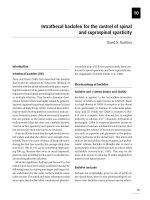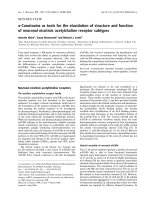Lecture Math for the pharmacy technician Concepts and calculations Chapter 3 – Lynn M. Egler, Kathryn A. Booth
Bạn đang xem bản rút gọn của tài liệu. Xem và tải ngay bản đầy đủ của tài liệu tại đây (2.47 MB, 74 trang )
Math for the Pharmacy Technician:
Concepts and Calculations
Egler • Booth
Chapter 3: Systems of
Measurement and Weight
McGraw-Hill
©2010 by the McGraw-Hill Companies, Inc All Rights Reserved
3-2
Systems of Weights and Measures
McGraw-Hill
©2010 by the McGraw-Hill Companies, Inc All Rights
3-3
Learning Objectives
When you have successfully completed Chapter 3, you will
have mastered skills to be able to:
Summarize metric notation.
Calculate equivalent measurements within
the metric system.
Identify the most frequently used
equivalent measurements among metric,
household, and apothecaries’
measurements.
Convert measurements between the
metric, household, and apothecary
systems of measurement.
McGraw-Hill
©2010 by the McGraw-Hill Companies, Inc All Rights
3-4
Learning Objectives
(con’t)
List the fundamental units of the metric
system for length, weight, and volume.
Recognize the symbols for dram, ounce,
grain, and drop.
Calculate temperature and time
conversions.
McGraw-Hill
©2010 by the McGraw-Hill Companies, Inc All Rights
3-5
Introduction
Large numbers of medications are
measured in grams and milligrams
(units of the metric system).
Understanding and converting systems
of weights and measures are required of
pharmacy technicians.
McGraw-Hill
©2010 by the McGraw-Hill Companies, Inc All Rights
3-6
Metric System
Widely used system of measurement in
the world today.
Defined in 1792, gets its name from the
meter (basic unit of length).
A meter is about three inches longer
than a yard.
See next slide for Table 3-1 “Basic Units
of Metric Measurement.”
McGraw-Hill
©2010 by the McGraw-Hill Companies, Inc All Rights
Table 3-1 Basic Units of Metric
Measurement
McGraw-Hill
3-7
©2010 by the McGraw-Hill Companies, Inc All Rights
3-8
Metric System
(con’t)
Meter and gram are abbreviated with
lowercase letters.
Liter is abbreviated with an uppercase L.
This minimizes the chance of confusion
between 1 and the lowercase L.
McGraw-Hill
©2010 by the McGraw-Hill Companies, Inc All Rights
3-9
Metric System
(con’t)
Length used for measurement such as
patient height.
Weight and volume are used to calculate
medications dosages.
McGraw-Hill
©2010 by the McGraw-Hill Companies, Inc All Rights
Understanding Metric
Notation
Metric system is based on multiples of 10.
Prefix before the basic unit indicates size.
Kilo – indicates you multiply the basic
unit by 1000.
3-10
Kilometer – 1000 meters
Kilogram – 1000 grams
Kiloliter – 1000 liters
When you divide a meter by 1000 equal
lengths, each length is one millimeter.
McGraw-Hill
©2010 by the McGraw-Hill Companies, Inc All Rights
Understanding Metric
Notation (con’t)
Prefix milli- means one-thousandth.
Millimeter is one-thousandth of a meter.
Milliliter is one-thousandth of a liter.
Milligram is one-thousandth of a gram.
See Tables 3-2 and 3-3 in your textbook
to visualize these concepts.
McGraw-Hill
3-11
©2010 by the McGraw-Hill Companies, Inc All Rights
3-12
Metric System Terms
Gram – measure unit of weight
Liter – unit of volume
Meter – unit of length
Centi- indicates
of the basic unit
1
100
Kilo – prefix indicates basic unit times 1000
1
Micro – indicates
of basic unit
1,000,000
McGraw-Hill
©2010 by the McGraw-Hill Companies, Inc All Rights
3-13
Basic Units of Metric
Measurement
Type of
Measure
Basic Unit
Abbreviation
Length
meter
m
Weight (or
Mass)
gram
g
Volume
liter
L
McGraw-Hill
©2010 by the McGraw-Hill Companies, Inc All Rights
Common Metric System
Prefixes
3-14
Prefix
Length
Value
kilo- (k)
kilometer
(km)
1 km = 1000 m
(basic unit)
meter (m)
1m
centi- (c)
centimeter
(cm)
McGraw-Hill
1 cm = 1 m
100
= 0.01 m
©2010 by the McGraw-Hill Companies, Inc All Rights
3-15
Common Metric System
Prefixes (con’t)
Prefix
Length
Value
milli- (m)
millimeter
(mm)
1 mm = 1 m
1000
0.001 m
micro- (mc
or μ )
micrometer
(mcm)
McGraw-Hill
1 mcm =
1
m
= 1,000,000
= 0.000001
©2010 by the McGraw-Hill Companies, Inc All Rights
3-16
Combining Prefixes and Units
(con’t)
Prefix
Length
(meter)
kilo-(x1000)
kilometer
km
kilogram
kg
kiloliter
kL
centi-(÷100)
centimeter
cm
centigram
cg
centiliter
cL
milli-(÷1000)
millimeter
mm
milligram
mg
milliliter
mL
micro( ÷1,000,000)
micrometer
mcm
microgram mcg
microliter
mcL
McGraw-Hill
Weight (Mass) Volume (liter)
(gram)
©2010 by the McGraw-Hill Companies, Inc All Rights
Understanding Metric
Notation
3-17
Use Arabic numerals, with decimals to
represent any fractions.
For example: Write 1.25 g to represent 1 1/4
g
If the quantity is less than 1, include a 0
before the decimal point. Delete any other
zeros that are not necessary.
For example: Do not write .750; write 0.75,
adding a zero before the decimal point and
deleting the unnecessary zero at the end.
McGraw-Hill
©2010 by the McGraw-Hill Companies, Inc All Rights
Understanding Metric
Notation (con’t)
3-18
Write the unit after the quantity with a
space between them.
McGraw-Hill
For example: Write 30 mg, not mg 30.
©2010 by the McGraw-Hill Companies, Inc All Rights
Understanding Metric
Notation (con’t)
3-19
Use lowercase letters for
metric abbreviations.
However, use uppercase L to
represent liter.
For example: Write mg, not M.
For example: Write mL, not ml.
McGraw-Hill
©2010 by the McGraw-Hill Companies, Inc All Rights
3-20
Review and Practice
Determine the correct metric
notation for six and two-eighths
milliliters.
a.
b.
c.
d.
McGraw-Hill
6.28mL
ml1 6.25
4
6 mL
6.25 mL
Answer d. 6.25 mL
©2010 by the McGraw-Hill Companies, Inc All Rights
Converting within the
Metric System
3-21
To convert a quantity from one
unit of metric measurement to
another:
1. Move the decimal point to the right if you
are converting from a larger unit to a
smaller unit.
2. Move the decimal point to the left if you are
converting from a smaller unit to a larger
unit.
McGraw-Hill
©2010 by the McGraw-Hill Companies, Inc All Rights
3-22
Review and Practice
1. Convert 4 L to mL.
4 L = 4.000 L = 4000 mL
2. How many m are in 75 mm?
75 mm = 75.0 mm = 0.075 m
McGraw-Hill
©2010 by the McGraw-Hill Companies, Inc All Rights
3-23
CAUTION
Remember: The larger the unit,
the smaller the quantity. The
smaller the unit, the larger the
quantity.
For example: 1 dollar bill = 4 quarters =
100 pennies
For example: 100 pennies = 4 quarters = 1
dollar bill
McGraw-Hill
©2010 by the McGraw-Hill Companies, Inc All Rights
3-24
Apothecary System
An old system of measurement
First used by apothecaries (early
pharmacists) and moved from Europe to
colonial America.
Household system evolved from the
apothecary system.
Very few medications are still measured
in apothecary units.
McGraw-Hill
©2010 by the McGraw-Hill Companies, Inc All Rights
3-25
Apothecary System Terms
Dram ( ) – common unit of volume in
the apothecary
Grain – basic unit
Minim ( ) – common unit of volume
Ounce ( ) – fluid ounces of volume
Unit (USP Unit) – amount of medication
to produce an effect
McGraw-Hill
©2010 by the McGraw-Hill Companies, Inc All Rights









